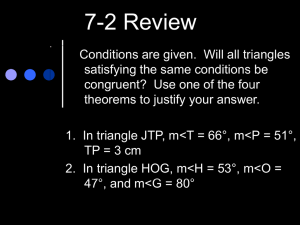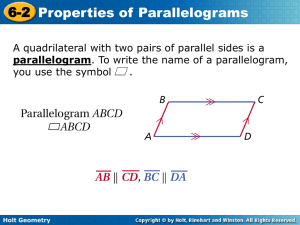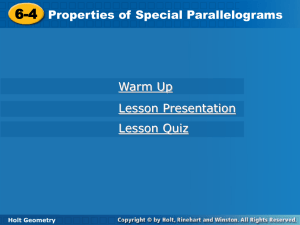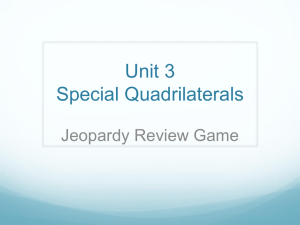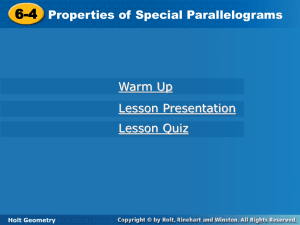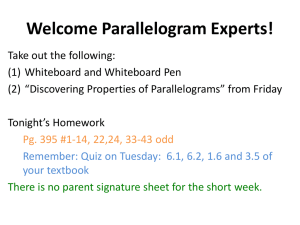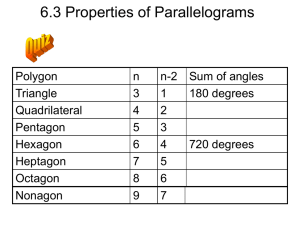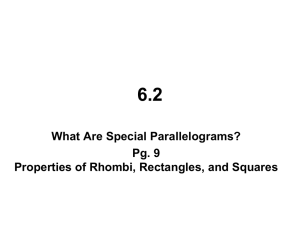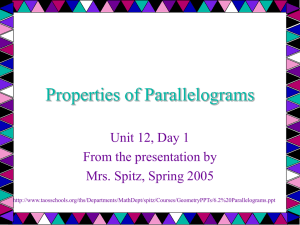Geo 6.5 Conditions for Special Parallelograms PPT
advertisement
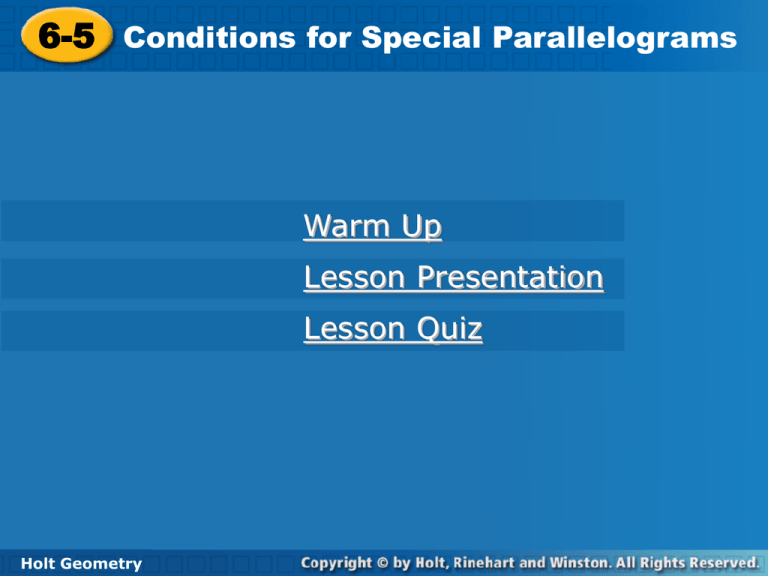
for Special Parallelograms 6-5 6-5 Conditions Conditions for Special Parallelograms Warm Up Lesson Presentation Lesson Quiz Holt Geometry Holt Geometry 6-5 Conditions for Special Parallelograms Do Now ABCD is a parallelogram. Justify each statement. 1. ABC CDA 2. AEB CED Holt Geometry 6-5 Conditions for Special Parallelograms Objective TSW prove that a given quadrilateral is a rectangle, rhombus, or square. Holt Geometry 6-5 Conditions for Special Parallelograms When you are given a parallelogram with certain properties, you can use the theorems below to determine whether the parallelogram is a rectangle. Holt Geometry 6-5 Conditions for Special Parallelograms Example 1: Carpentry Application A manufacture builds a mold for a desktop so that , , and mABC = 90°. Why must ABCD be a rectangle? Holt Geometry 6-5 Conditions for Special Parallelograms Example 2: Carpentry Application Holt Geometry 6-5 Conditions for Special Parallelograms Example 3 A carpenter’s square can be used to test that an angle is a right angle. How could the contractor use a carpenter’s square to check that the frame is a rectangle? Holt Geometry 6-5 Conditions for Special Parallelograms Below are some conditions you can use to determine whether a parallelogram is a rhombus. Holt Geometry 6-5 Conditions for Special Parallelograms Caution In order to apply the Theorems in section 6.5, the quadrilateral must be a parallelogram. To prove that a given quadrilateral is a square, it is sufficient to show that the figure is both a rectangle and a rhombus. Holt Geometry 6-5 Conditions for Special Parallelograms Remember! You can also prove that a given quadrilateral is a rectangle, rhombus, or square by using the definitions of the special quadrilaterals. Holt Geometry 6-5 Conditions for Special Parallelograms Example 3: Applying Conditions for Special Parallelograms Determine if the conclusion is valid. If not, tell what additional information is needed to make it valid. Given: Conclusion: EFGH is a rhombus. Holt Geometry 6-5 Conditions for Special Parallelograms Example 4: Applying Conditions for Special Parallelograms Determine if the conclusion is valid. If not, tell what additional information is needed to make it valid. Given: Conclusion: EFGH is a square. Holt Geometry 6-5 Conditions for Special Parallelograms Example 5 Determine if the conclusion is valid. If not, tell what additional information is needed to make it valid. Given: ABC is a right angle. Conclusion: ABCD is a rectangle. Holt Geometry 6-5 Conditions for Special Parallelograms Example 6: Identifying Special Parallelograms in the Coordinate Plane Use the diagonals to determine whether a parallelogram with the given vertices is a rectangle, rhombus, or square. Give all the names that apply. P(–1, 4), Q(2, 6), R(4, 3), S(1, 1) Holt Geometry 6-5 Conditions for Special Parallelograms Example 6 Continued Step 1 Graph Holt Geometry PQRS. 6-5 Conditions for Special Parallelograms Holt Geometry 6-5 Conditions for Special Parallelograms Example 7: Identifying Special Parallelograms in the Coordinate Plane Use the diagonals to determine whether a parallelogram with the given vertices is a rectangle, rhombus, or square. Give all the names that apply. W(0, 1), X(4, 2), Y(3, –2), Z(–1, –3) Step 1 Graph Holt Geometry WXYZ. 6-5 Conditions for Special Parallelograms Holt Geometry 6-5 Conditions for Special Parallelograms Example 8 Use the diagonals to determine whether a parallelogram with the given vertices is a rectangle, rhombus, or square. Give all the names that apply. K(–5, –1), L(–2, 4), M(3, 1), N(0, –4) Holt Geometry 6-5 Conditions for Special Parallelograms Example 8 Continued Step 1 Graph Holt Geometry KLMN. 6-5 Conditions for Special Parallelograms Holt Geometry 6-5 Conditions for Special Parallelograms Example 9 Use the diagonals to determine whether a parallelogram with the given vertices is a rectangle, rhombus, or square. Give all the names that apply. P(–4, 6) , Q(2, 5) , R(3, –1) , S(–3, 0) Holt Geometry 6-5 Conditions for Special Parallelograms Example 9 Continued Step 1 Graph Holt Geometry PQRS. 6-5 Conditions for Special Parallelograms Holt Geometry 6-5 Conditions for Special Parallelograms Lesson Quiz: Part I 1. Given that AB = BC = CD = DA, what additional information is needed to conclude that ABCD is a square? Holt Geometry 6-5 Conditions for Special Parallelograms Lesson Quiz: Part II 2. Determine if the conclusion is valid. If not, tell what additional information is needed to make it valid. Given: PQRS and PQNM are parallelograms. Conclusion: MNRS is a rhombus. valid Holt Geometry 6-5 Conditions for Special Parallelograms Lesson Quiz: Part III 3. Use the diagonals to determine whether a parallelogram with vertices A(2, 7), B(7, 9), C(5, 4), and D(0, 2) is a rectangle, rhombus, or square. Give all the names that apply. AC ≠ BD, so ABCD is not a rect. or a square. The slope of AC = –1, and the slope of BD = 1, so AC BD. ABCD is a rhombus. Holt Geometry
